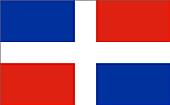Northwest Horticultural Council
Export Manual
DOMINICAN REPUBLIC
 Capital: Santo Domingo
Capital: Santo Domingo
Population: 10,815,857 (2024)
Currency: Peso
Official Language(s): Spanish
I. CHEMICAL MAXIMUM RESIDUE LEVELS (MRLs)
Please click on the above link for a list of Codex chemical MRLs.
II. CHEMICALS AND ADDITIVE INFORMATION
A. Chemical residue standards:
The Dominican Republic defers to maximum residue levels established by the Codex Alimentarius Commission. If Codex tolerances are not established, the Dominican Republic will accept U.S. values followed by European Union values.
B. Monitoring chemical residues:
The Dominican Republic does not actively monitor residues in imported fruit.
C. Restrictions on use of waxes:
None.
III. ORGANIC FRUIT REGULATIONS
No information.
IV. TARIFFS
As agreed under the Dominican Republic-Central America-United States Free Trade Agreement, the tariff rate for U.S. apples, pears, and cherries is zero.
In order for importers to obtain this preferential duty-free rate, a Certificate of Origin must be provided. See section Chapter V, Section F for more information.
V. NON-TARIFF BARRIERS
A. Labeling requirements:
U.S. grading standards and labeling requirements are used.
B. Licenses and quotas:
An import permit issued by the Central Bank is required. The commercial invoice, bill of lading and consular invoice must all be certified by a Dominican consular representative in the country of origin, which can usually be completed the same day.
C. Currency Issues:
None.
D. Pest and plant disease restrictions:
A Phytosanitary Certificate (PC) and Import Permit (IP) are required. The IP may contain additional phytosanitary requirements. Shippers are encouraged to review the IP prior to export. Fruit must have originated outside an area regulated by the USDA for the Mediterranean fruit fly and oriental fruit fly. Neither of these pests occur in the Pacific Northwest. If the fruit transits an area regulated by the USDA for these pests, the fruit must be in closed or covered containers. An additional declaration (AD) is required that “The products in this shipment were grown and packed in areas free of Medfly (Ceratitis capitata).” AND, “The product(s) in this shipment originated in an area not regulated for harmful species of fruit flies.”
Shippers should note that codling moth is considered a pest of quarantine concern in the Dominican Republic. Loads of apples with detectable codling moth larvae have been refused entry. USDA’s Animal and Plant Health Inspection Service office in Santo Domingo has informed the NHC that produce refused entry for phytosanitary reasons must be re-exported or destroyed, as the Dominican Republic does not have facilities for post-entry fumigation.
E. Certificate of Origin
A Certificate of Origin must accompany any shipment in order to obtain the preferential duty-free tariff provided under the DR-CAFTA.
There is no official Certification of Origin form. However, a “suggested form” for imports under DR-CAFTA, including instructions on how to fill in the form may be found at Certificate of Origin.
Special attention should be paid to entering the correct “preferential tariff treatment criteria” under box 7 of the suggested form. For fruit exported from the Pacific Northwest, the correct entry is the capital letter A; which designates the import as “it is a good wholly obtained or produced entirely in the territory of one or more of the Parties.
VI. MARKETING REPRESENTATIVES FOR PACIFIC NORTHWEST TREE FRUIT INDUSTRY:
Washington Apple Commission:
Tatiana Quiros
E-mail: jcmets123@gmail.com
Pear Bureau Northwest:
Luis Moreno
Grupo PM S.A. de C.V.
Cuernavaca, Mexico
Voice: +52 777 316 7370
Fax: +52 777 316 7369
E-mail: grupopm@grupopm.com
VII. OTHER RESOURCE LINKS:
Governmental:
VIII. ADDITIONAL COMMENTS
The Dominican Republic-Central America-United States Free Trade Agreement Implementation Act was signed by President Bush on August 2, 2005. This FTA entered into force in the Dominican Republic on March 1, 2007.
Only very small quantities of apples are produced commercially. Local production of pears is minimal and there is no cherry production.
Apples and pears constitute a growing market in the Dominican Republic as consumption grows from holiday season to year-round demand. Climatic conditions do not support large increases in local commercial production and some of the current growing regions have recently been designated as forest conservation zones. Nonetheless, domestic producers are extremely protectionist and continue to periodically lobby the government for stronger import restrictions.

